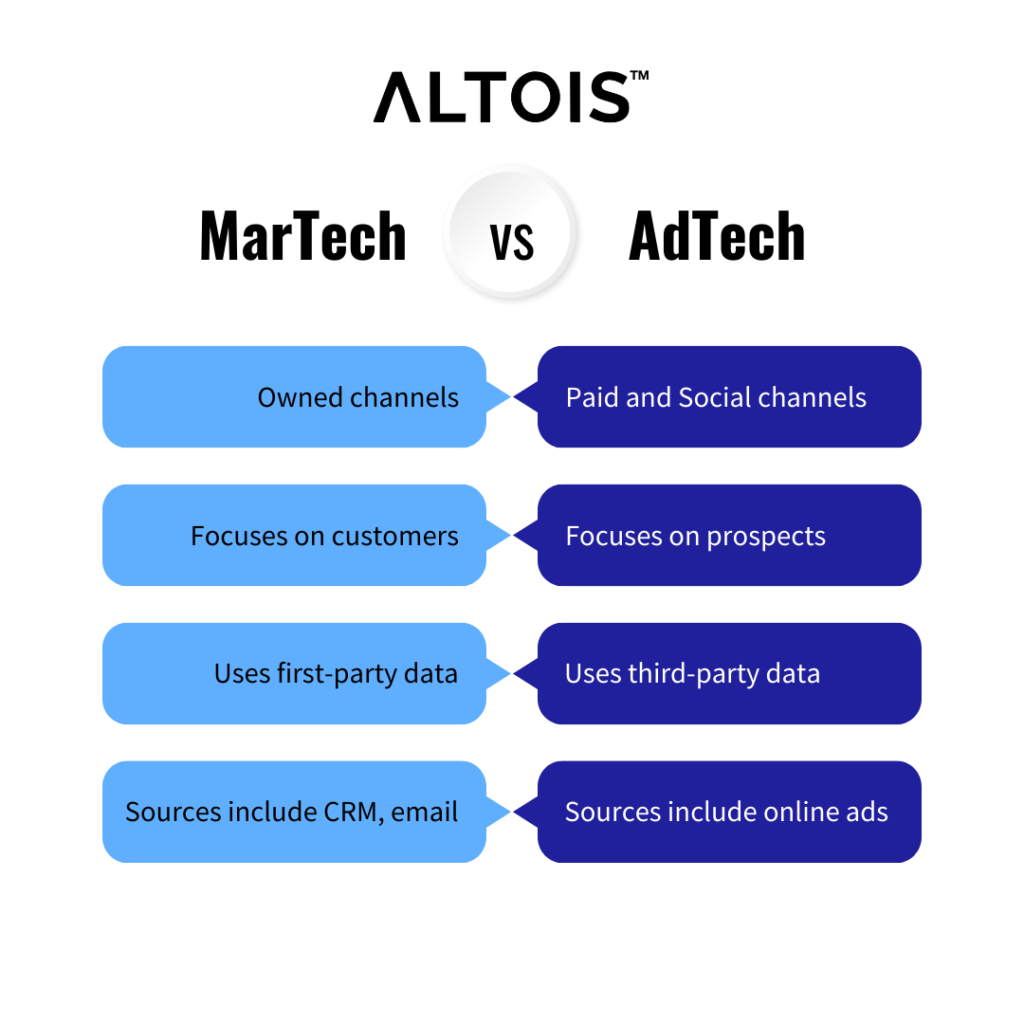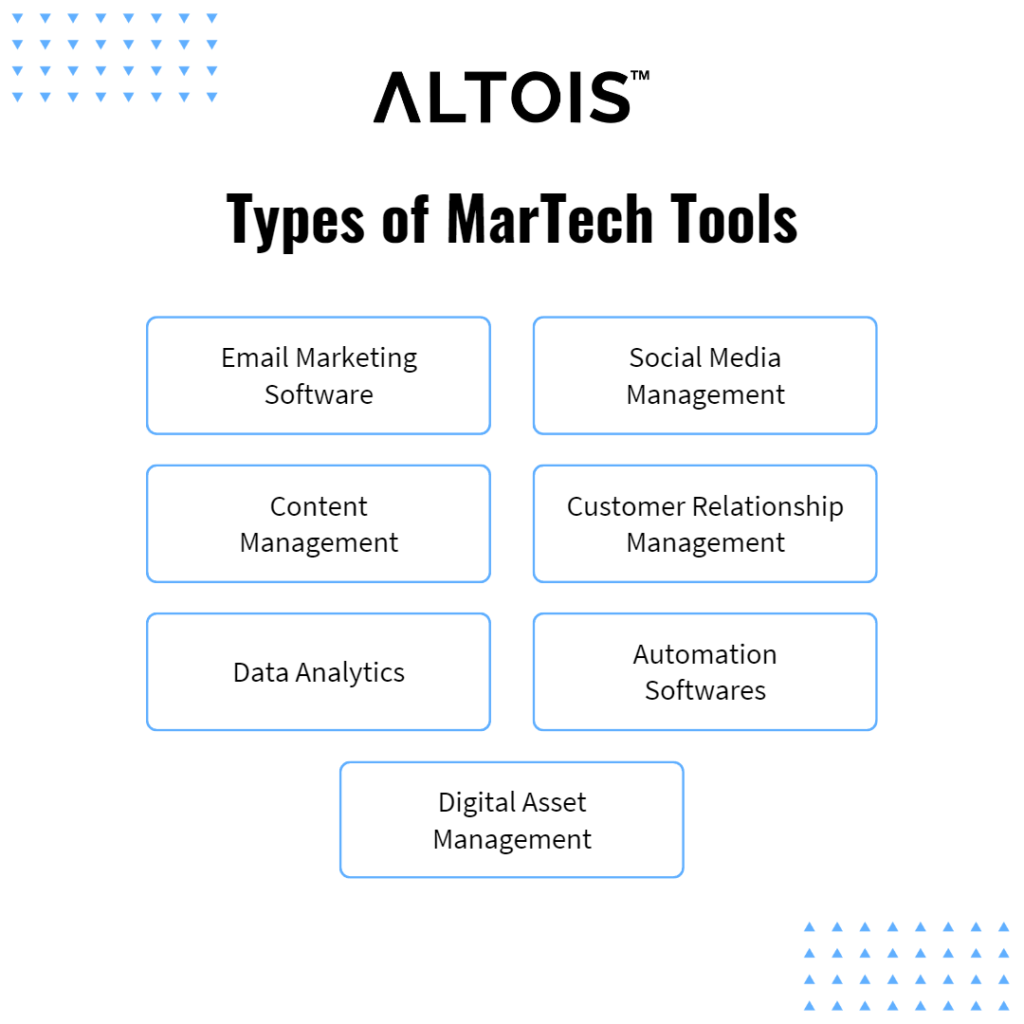Introduction
Marketing technology (or MarTech) is a new branch of marketing based on the use of technology to improve marketing performance. It includes various software, data, and hardware used in supporting, measuring and analysing marketing activities.
Additionally, martech tools often provide marketers with access to valuable data and insights that can help them better understand their customers and improve their marketing strategies.
The marketing technology landscape has changed dramatically in recent years, shifting from traditional media to digital channels. With the introduction of social media, mobile devices and e-commerce, marketers have reached customers more efficiently than ever.
Many companies now have dedicated teams that focus specifically on martech, and there is a growing ecosystem of vendors and service providers.
Benefits
Marketing technology has become an integral part of the marketing process. It has grown exponentially in the past few years. The benefits of marketing technology are immense, and there are many ways to use it.
It can be used to generate leads, create content and optimise campaigns. However, the best part about marketing technology is that it saves time for marketers by automating tedious tasks like emailing or updating social media profiles.
One can’t imagine a modern-day marketing campaign without the use of marketing technology. As a result, how we do business and interact with customers, prospects, and partners is rapidly changing.
Importance
Marketing technology is important because it allows marketers to automate and streamline their marketing processes, making it easier and more efficient to reach and engage with customers. Martech tools can also provide marketers with access to valuable data and insights that can help them better understand their customers and improve their marketing strategies.
Some specific benefits of martech include:
- Improved efficiency: Martech tools can help marketers save time by automating repetitive tasks and streamlining their workflows.
- Better targeting and personalization: It can provide marketers with data and insights that can help them better understand their audience and tailor their marketing efforts to meet their needs.
- Enhanced customer engagement: It can help marketers engage with customers across multiple channels, such as email, social media, and mobile, and can provide valuable data and insights about customer behaviour and preferences.
- Improved marketing ROI: Marketers can optimize and measure the performance of their marketing campaigns, marketers can improve the return on investment of their marketing efforts.
Difference between MarTech and AdTech
Marketing technology (martech) and advertising technology (adtech) are similar in that they both refer to tools and technologies that are used to support marketing and advertising efforts. However, there are some key differences between the two.
One main difference between martech and adtech is the scope of their focus. Martech tools are typically focused on supporting a wide range of marketing activities, such as email marketing, content management, and customer relationship management. In contrast, adtech tools are specifically focused on supporting advertising efforts, such as buying and selling advertising space, targeting and retargeting ads, and tracking the performance of ad campaigns.
Another difference is the type of technology they use. Martech tools often rely on a combination of software and data analysis to support marketing activities, whereas adtech tools may make use of more specialized technology, such as programmatic advertising platforms and ad exchanges.

Types
Martech tools can help with a wide range of tasks, including email marketing, social media management, content marketing, customer relationship management (CRM), and more. Some common types of tools include:
Email Marketing Software
Email marketing software allows marketers to create, send, and track the performance of email marketing campaigns. These tools can be used to send newsletters, promotional offers, and other types of email communications to customers and prospects.
It includes features such as templates and design tools, list management, segmentation, and reporting and analytics. These tools can help marketers create professional-looking emails, manage their email lists, and track the performance of their campaigns.
Using email marketing software can help marketers improve the efficiency and effectiveness of their email marketing efforts. It can also provide valuable data and insights that can help marketers better understand their audience and tailor their emails to meet their needs.
Social Media Management
Social media management is a type of marketing technology that is used to manage a brand’s presence on social media platforms. These tools allow marketers to schedule and publish posts, track the performance of social media campaigns, and engage with followers and fans.
Social media management tools include tools for scheduling, analytics, and collaboration. These tools can help marketers save time by allowing them to schedule posts in advance and can provide valuable data and insights about the performance of their social media campaigns. Many social media management tools also include collaboration features, allowing team members to work together to manage a brand’s social media presence.
It helps marketers improve the efficiency and effectiveness of their social media marketing efforts. It can also provide valuable data and insights that can help marketers better understand their audience and tailor their content to meet their needs. Overall, social media management is an important part of many martech stacks.
Content Management
Content management software (CMS) is a type of marketing technology that is used to create, manage, and publish content, such as blog posts, articles, and videos. These tools allow marketers to create and update content easily and can be used to publish content on a variety of channels, such as websites, social media platforms, and email newsletters.
CMS software typically includes features such as templates and design tools, workflow and collaboration, and analytics and reporting. These tools can help marketers create professional-looking content, manage the editorial process, and track the performance of their content.
It can help marketers improve the efficiency and effectiveness of their content marketing efforts. It can also provide valuable data and insights that can help marketers better understand their audience and tailor their content to meet their needs.
Customer Relationship Management
Customer relationship management (CRM) software is a type of marketing technology that is used to manage customer interactions and data. These tools can be used to support a variety of marketing activities, such as lead generation, customer service, and personalized communications.
CRM software typically includes features such as contact management, sales and marketing automation, and analytics. These tools can help marketers track and manage customer interactions, such as phone calls, emails, and social media messages. They can also be used to automate certain tasks, such as sending follow-up emails or scheduling appointments.
Using CRM software can help marketers improve the efficiency and effectiveness of their marketing efforts. It can also provide valuable data and insights that can help marketers better understand their customers and tailor their marketing strategies to meet their needs.
Data Analytics
Marketing data analytics software provides data about how your customers are interacting with your website, such as how many people are viewing your site, what they are clicking on and whether they’re spending money on your products. This can help you develop a marketing strategy that will help you to grow your business.
Data analysis is a key component of many marketing technology tools. These tools allow marketers to collect, analyze, and visualize data from a variety of sources, such as web analytics and customer feedback surveys. This data can provide valuable insights into customer behaviour and preferences, as well as the performance of marketing campaigns.
Data analysis tools may include features such as dashboards and reports, data visualization, and predictive analytics. These tools can help marketers identify trends, patterns, and insights in their data and can be used to support a wide range of marketing activities, such as targeting and segmentation, personalization, and optimization.
Using data analysis can help marketers make more informed decisions and improve the effectiveness of their marketing efforts. It can also provide valuable insights into customer behaviour and preferences, allowing marketers to better understand and engage with their audience.
For example, if you notice that the percentage of people who have visited the site for less than 30 seconds is high, this may indicate a poorly designed login process or that the messaging is confusing.
Marketing Automation
Marketing automation software simplifies repetitive tasks like campaign management, content creation, lead nurturing, email marketing, social media management etc., by automating them with a single click or tap. It also provides real-time overviews of all your activities and allows you to analyse your data in a more detailed manner.
Using marketing automation can help marketers save time and improve the consistency of their marketing efforts. It can also provide valuable data and insights that can help marketers better understand their customers and improve their marketing strategies. Overall, marketing automation is an important part of many martech stacks.
Digital Asset Management
Digital asset management (DAM) is a type of marketing technology (martech) tool that is used to store, organize, and manage digital assets such as images, videos, and documents. These assets are often used in marketing campaigns, and a DAM system can help marketers easily access, share, and track the use of these assets.
A DAM system typically includes features such as a centralized repository for storing assets, access controls to manage who can access and use the assets, and tools for organizing and tagging assets to make them easier to find. Additionally, many DAM systems include tools for collaborating with team members, as well as tracking the usage of assets to ensure that they are being used properly.
Using a DAM system can help marketers save time and improve the efficiency of their workflows by providing a central location for storing and managing digital assets. It can also help improve the consistency and accuracy of marketing campaigns by ensuring that the right assets are being used in the right contexts. Overall, DAM systems can be a valuable addition to a tech stack.
These are just a few examples of the many different types of martech tools that are available. The specific tools that are included in a stack will depend on the needs and goals of the individual or organization using them.

What is a MarTech Stack?
MarTech Stack is a term that refers to the marketing software and technologies that are used for marketing purposes. The marketing technology stack provides marketers with the tools to successfully run their campaigns. For example, it can help them manage their data and customer relationships more efficiently. It also allows marketers to track customer behaviour in real-time and adjust accordingly.
How to Build a MarTech Stack?
To build a tech stack, you will need to identify the specific tools and technologies that will best support your marketing goals and objectives. Here are some steps you can follow to build your own stack:
Identify your marketing goals and objectives
Before you start building your stack, it’s important to define your goals and objectives clearly. This will help you determine which tools and technologies are most relevant to your needs.
Research and compare different tools
There are many different tools and technologies available, so it’s important to research and compare your options to find the ones that are the best fit for your business. Look for tools that have a good track record and positive customer reviews, and consider the features and capabilities that each tool offers.
Determine your budget
Martech tools can vary in price, so it’s important to determine your budget and look for tools that are within your price range. Keep in mind that investing in high-quality tools can pay off in the long run by improving the efficiency and effectiveness of your marketing efforts.
Create a plan for implementing and using your martech stack
Once you’ve identified the tools you want to include in your stack, you’ll need to create a plan for implementing and using them. This may include training your team on how to use the tools, integrating the tools with your existing marketing systems, and creating processes and protocols for using the tools effectively.
Monitor and review your martech stack
As you start using your stack, it’s important to monitor and review its performance to ensure that it is meeting your goals and objectives. This may involve tracking key performance indicators (KPIs), gathering feedback from your team, and making adjustments as needed to improve the effectiveness of your tack.
Overall, building a stack involves researching and comparing different tools, determining your budget, creating a plan for implementation, and regularly reviewing and adjusting your stack to ensure that it is meeting your needs.
Future Scope and Predictions
The marketing technology landscape is changing exponentially, and the future scope of marketing technology is exciting.
In the past, marketers had to rely on a few tools to do their jobs. Today, hundreds of marketing technologies can be used to achieve different objectives.
The future of marketing technology will be driven by advancements in artificial intelligence, automation, and data science.
Marketing automation, for instance, is all about using data to understand customer behaviour and then automate specific responses to their needs. This marketing technique is best used in B2B environments because it relies on lead scoring and nurturing.
AI will help marketers make more intelligent decisions by providing them with insights that would otherwise take too long to generate manually or with traditional methods. AI will also help automate tasks such as lead scoring and lead nurturing, which are currently done manually.
Data science will help marketers understand the customer journey better so they can personalise their messaging across channels more effectively.
Are you planning to implement a MarTech stack for your business? With 6+ years of experience in marketing automation, Altois can help you generate revenue with a stack that works every time.
Book a consultation with our MarTech experts


